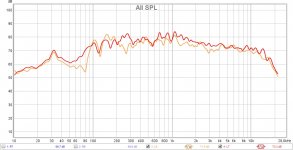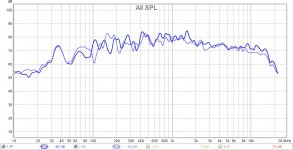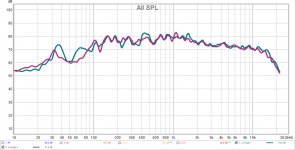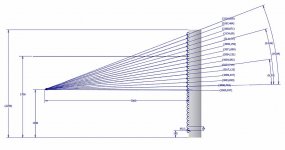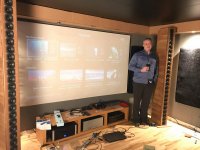Apparently there are some FIR options available, so we´ll see how that work later  I have done a system check and have the miniDSP operational and spent a little time getting to know the interface and functions. Did do a quick measure/generate EQ profile and import this to the miniDSP and got that workflow down. Freq. repsonse became better but distortion went up as well, beyond what I had with the analoge EQ.
I have done a system check and have the miniDSP operational and spent a little time getting to know the interface and functions. Did do a quick measure/generate EQ profile and import this to the miniDSP and got that workflow down. Freq. repsonse became better but distortion went up as well, beyond what I had with the analoge EQ.
When I get the chance I need to measure each part og the array (LeftTop/LeftBottom and RightTop/RightBottom) so I have a good base line.
Then I can start to play with the profiles - and get to know them and choose my favourite
 I have done a system check and have the miniDSP operational and spent a little time getting to know the interface and functions. Did do a quick measure/generate EQ profile and import this to the miniDSP and got that workflow down. Freq. repsonse became better but distortion went up as well, beyond what I had with the analoge EQ.
I have done a system check and have the miniDSP operational and spent a little time getting to know the interface and functions. Did do a quick measure/generate EQ profile and import this to the miniDSP and got that workflow down. Freq. repsonse became better but distortion went up as well, beyond what I had with the analoge EQ. When I get the chance I need to measure each part og the array (LeftTop/LeftBottom and RightTop/RightBottom) so I have a good base line.
Then I can start to play with the profiles - and get to know them and choose my favourite
Here are the non-EQ measurements from sweet spot for top right (RT), bottom right
(RB) and LT/LB (1/12 smoothered). The idea is to use these measurements to generate EQ-profiles I can play with. (1/12 smoothered)
Measurements are done at 80dB calibrated.
For the Left side there is a bigger difference between top/bottom group between 40-90hz, otherwise they are more or less on line with eachother.
There is also a 3rd plot with the average response from RT+RB is shown, along to LT/LB.
(RB) and LT/LB (1/12 smoothered). The idea is to use these measurements to generate EQ-profiles I can play with. (1/12 smoothered)
Measurements are done at 80dB calibrated.
For the Left side there is a bigger difference between top/bottom group between 40-90hz, otherwise they are more or less on line with eachother.
There is also a 3rd plot with the average response from RT+RB is shown, along to LT/LB.
Attachments
Last edited:
For no EQ measurements these are not bad at all. Don't try and boost both ends alone. Shave off some energy in the middle so it get's more leveled out. I shave off 10 dB of energy in the lower mid frequencies to arrive at a flat target.
I had expected to see more output at 200-300 Hz, but that might be because you ran these in sections, making them act as finite arrays instead of a floor to ceiling array.
Except to maybe be able to fix bottom end problems I wouldn't run the top and bottom separate from each other. As that removes their "virtually endless" array advantages.
On that note, after further thinking about it.... you have the wiring of each diver accessible at the back right? Two sections make up the entire floor to ceiling array.
I would connect the top most 6 drivers to the bottom 6. have a middle section of 12 drivers covering both seated and standing up distances. I may even use the lower 4 and upper 8 if that covers both standing and seated positions better. That way you could run a limited section for the top frequencies is you were inclined to experiment with such a thing. In theory that would reduce comb filtering as there is less difference between each driver and ear position for that middle section. the outer array would get a gradual cross filter to shave off anything above ~5 KHz or something like that. A unique opportunity to play with.
However much you hear about driver center to center spacing, that's not what these arrays are about. While it would still be an advantage to bring that spacing down, in the end at listening distances it's the driver to ear spacing that will determine comb filtering from that first wave front to hit your ear position. More drivers with closer spacing average better at the ear, that's true. But due to having this length in an array it just isn't comparable to having 2 drivers play within quarter wave CTC position. As no matter how many drivers you'd use, the outer drivers in the array are further away from your ear position than the center drivers. As said, it has advantages having more drivers at closer spacing but that's working a bit different than most asume.
I had expected to see more output at 200-300 Hz, but that might be because you ran these in sections, making them act as finite arrays instead of a floor to ceiling array.
Except to maybe be able to fix bottom end problems I wouldn't run the top and bottom separate from each other. As that removes their "virtually endless" array advantages.
On that note, after further thinking about it.... you have the wiring of each diver accessible at the back right? Two sections make up the entire floor to ceiling array.
I would connect the top most 6 drivers to the bottom 6. have a middle section of 12 drivers covering both seated and standing up distances. I may even use the lower 4 and upper 8 if that covers both standing and seated positions better. That way you could run a limited section for the top frequencies is you were inclined to experiment with such a thing. In theory that would reduce comb filtering as there is less difference between each driver and ear position for that middle section. the outer array would get a gradual cross filter to shave off anything above ~5 KHz or something like that. A unique opportunity to play with.
However much you hear about driver center to center spacing, that's not what these arrays are about. While it would still be an advantage to bring that spacing down, in the end at listening distances it's the driver to ear spacing that will determine comb filtering from that first wave front to hit your ear position. More drivers with closer spacing average better at the ear, that's true. But due to having this length in an array it just isn't comparable to having 2 drivers play within quarter wave CTC position. As no matter how many drivers you'd use, the outer drivers in the array are further away from your ear position than the center drivers. As said, it has advantages having more drivers at closer spacing but that's working a bit different than most asume.
Last edited:
Make that 8 drivers at the bottom connected to 4 drivers up top as in standing position one would be closer to the top than at seating position towards the bottom driver.
9 - 5 could also be done.
I have considered something close to an expanding array, as seen from a listening position in my design phase. It was a backup plan if a full range array did not work out.
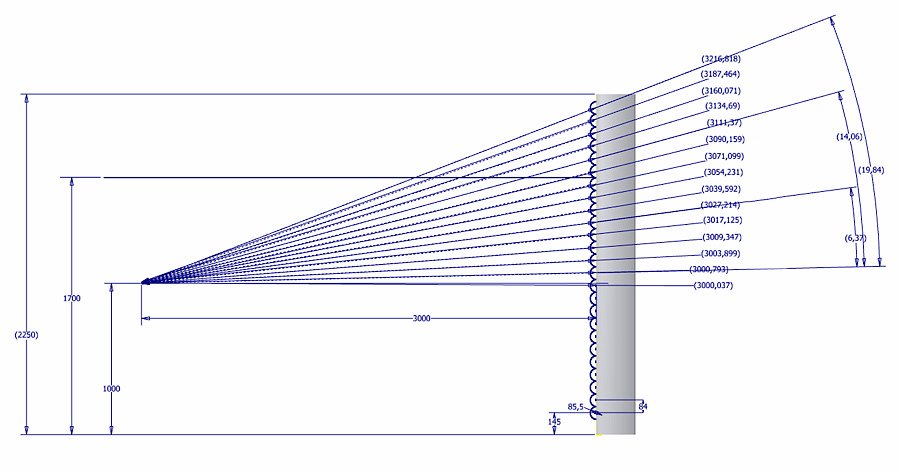
a chart showing driver to ear distances that can be calculated back to (quarter) wave length differences
9 - 5 could also be done.
I have considered something close to an expanding array, as seen from a listening position in my design phase. It was a backup plan if a full range array did not work out.
a chart showing driver to ear distances that can be calculated back to (quarter) wave length differences
Attachments
Thanks for your time Ronald 
Yes, all individual wires are available from the rear and can be reconfigured as seen fit. I like the idea of re-arranging the configuration to a mid-section and an outer section, or shift to 8bottom+4top / 12 mid config I havent considered any shading schemes yet, as you say it void the infinite array principle. Running each group (Top/Bottom) was primarely done to check for differences, but as you say they are then not considered infinite any longer. So perhaps two groups of bottom / top 6 drivers and 12 center is a better way to do it, that way each group is symmetric along the vertical axis?
I havent considered any shading schemes yet, as you say it void the infinite array principle. Running each group (Top/Bottom) was primarely done to check for differences, but as you say they are then not considered infinite any longer. So perhaps two groups of bottom / top 6 drivers and 12 center is a better way to do it, that way each group is symmetric along the vertical axis?
I have very briefly started to play with the EQ options, and I primarely "cut" down to where the low SPL reside. Cut instead of boost. The automated EQ filters REW suggest are many (10) and I need to learn what does what, where. That way I might be able to reduce the number (and amount each does) to a better minimum.
I realize the EQ-addition wont be settled "tomorrow"
Yes, all individual wires are available from the rear and can be reconfigured as seen fit. I like the idea of re-arranging the configuration to a mid-section and an outer section, or shift to 8bottom+4top / 12 mid config
I have very briefly started to play with the EQ options, and I primarely "cut" down to where the low SPL reside. Cut instead of boost. The automated EQ filters REW suggest are many (10) and I need to learn what does what, where. That way I might be able to reduce the number (and amount each does) to a better minimum.
I realize the EQ-addition wont be settled "tomorrow"
Last edited:
The infinite array has 3 benefits: vertical directivity and -3db per doubling of distance extended down to DC and frequency response independent of height. In real rooms, the latter isn't perfect but the first two seem to hold.
One could also argue that the infinite array is a detriment at the high end of the spectrum since it also includes the HF rolloff that needs to be compensated and floor and ceiling reflections contribute to combing. In Vituix simulation I can see very significant difference in HF combing turning floor and ceiling reflections on and off. Given the frequencies at which combing occurs, I would think carpeting would be sufficient floor absorption.
I guess I am arguing for shading although it seems may not have sufficient amp and eq channels to take full advantage of the concept. You might look at last year's CBT thread to see how to do 3 group shading with different series/parallel driver group wiring plus a couple of resistors. If you do shading be sure the unshaded group spans seated through standing ear heights.
OTOH: I can see from your baseline measurements that you will have little trouble arriving at an excellent solution without shading. Unless your listening distance is close (i.e. closer than 3m or so) combing shouldn't be much of an issue.
re' REW auto eq:
I wouldn't relay primarlly on that. Instead, do your high and low shelf filters with IIR PEQs in the miniDSP and spend the remaining PEQs on the low frequency peaks you need to cut. in the 2x4HD you have a relatively small number of taps which will limit your low frequency resolution.
One could also argue that the infinite array is a detriment at the high end of the spectrum since it also includes the HF rolloff that needs to be compensated and floor and ceiling reflections contribute to combing. In Vituix simulation I can see very significant difference in HF combing turning floor and ceiling reflections on and off. Given the frequencies at which combing occurs, I would think carpeting would be sufficient floor absorption.
I guess I am arguing for shading although it seems may not have sufficient amp and eq channels to take full advantage of the concept. You might look at last year's CBT thread to see how to do 3 group shading with different series/parallel driver group wiring plus a couple of resistors. If you do shading be sure the unshaded group spans seated through standing ear heights.
OTOH: I can see from your baseline measurements that you will have little trouble arriving at an excellent solution without shading. Unless your listening distance is close (i.e. closer than 3m or so) combing shouldn't be much of an issue.
re' REW auto eq:
I wouldn't relay primarlly on that. Instead, do your high and low shelf filters with IIR PEQs in the miniDSP and spend the remaining PEQs on the low frequency peaks you need to cut. in the 2x4HD you have a relatively small number of taps which will limit your low frequency resolution.
Very interesting progress here now guys .... I have never been fully wow'ed by the line arrays and maybe it´s the inifinite array principle that bugs me..... there is just something happening to the soundstage that I can't fully connect to, like Mark Knopfler's head is 1.5 meter high ... everything else is just mindblowing but there is this thing that it seems unaturally large to me...
Somehow I have always connected better to more "point source" type of speakers but they don't have those insane qualities of a fully capable line source...
Maybe the expanding array changes a lot of these things ....
I heard some new linesource speakers from Norwegian Adyton that seem to be much better in these qualities (Adyton Gracili)
I talked a lot to the designer, Geir Fredriksen, but he holds his cards tight, of course .... but he is an extremely nice guy though
There is one thing that bugs me with those minidsp's though ... on these basic models there seem to be no physical indication of volume and if that's your main volume control... and the system is capable of 125+ dB ... you don´t want any mistakes to happen here and just the theoretical opportunity of this happening scares me somehow
Or, I am just thinking 135db+ capable subwoofers firing off ...


Somehow I have always connected better to more "point source" type of speakers but they don't have those insane qualities of a fully capable line source...
Maybe the expanding array changes a lot of these things ....
I heard some new linesource speakers from Norwegian Adyton that seem to be much better in these qualities (Adyton Gracili)
I talked a lot to the designer, Geir Fredriksen, but he holds his cards tight, of course .... but he is an extremely nice guy though
There is one thing that bugs me with those minidsp's though ... on these basic models there seem to be no physical indication of volume and if that's your main volume control... and the system is capable of 125+ dB ... you don´t want any mistakes to happen here and just the theoretical opportunity of this happening scares me somehow
Or, I am just thinking 135db+ capable subwoofers firing off ...
Last edited:
How I hope BYRTT will comment on this as he has heard my lines twice now. And for quite a long period of time and also with his own preferred music.
I don't get that overblown size on imaging. You shouldn't have to get it with arrays, as long as the speaker and room can actually work together (low level of early reflections etc.).
But... as said, I hope BYRTT will comment on this as I am probably biased. What the arrays do in my treated room is project the image that's in the song. Small when it is small like girl + guitar music and huge if it's in the recording, surpassing the width of the speakers, projecting in front and to the back of array positions if I have mid/side compensation on.
I don't get that overblown size on imaging. You shouldn't have to get it with arrays, as long as the speaker and room can actually work together (low level of early reflections etc.).
But... as said, I hope BYRTT will comment on this as I am probably biased. What the arrays do in my treated room is project the image that's in the song. Small when it is small like girl + guitar music and huge if it's in the recording, surpassing the width of the speakers, projecting in front and to the back of array positions if I have mid/side compensation on.
I've heard that the overlarge image phenomena goes away with time. I don't know if I don't hear it or simply don't recognize it; at any rate nothing like that bothers me. If you do want an "insane" point source experience, look into Synergies. I think if you build a straight line array and electronically delay curve it (e.g. CBT) you can get the point source effect back in the vertical plane. As you say, there is so much to like about these arrays and their footprint is so much more room friendly than a large horn.
As to your volume control: I don't have a physical volume control and don't miss it, except nostalgically. I play from a computer and use a mouse to control volume. The players seem to default to low volumes and in any case I have to select something to play first before a sound is made. If I want, I can bring up my miniDSP app and activate its level meter. There is seldom a point to that unless checking gain staging. I've only a couple of loud SPL accidents and they were with REW, before an SPL limit was implemented in REW. As I recall, at least some of the MIniDSPs include a limiter/compressor that you can configure to protect your ears.
Actually, my MinidSP 4x10 does have a physical volume control but I just set and forget it. Its just a rotary encoder, anyway.
As to your volume control: I don't have a physical volume control and don't miss it, except nostalgically. I play from a computer and use a mouse to control volume. The players seem to default to low volumes and in any case I have to select something to play first before a sound is made. If I want, I can bring up my miniDSP app and activate its level meter. There is seldom a point to that unless checking gain staging. I've only a couple of loud SPL accidents and they were with REW, before an SPL limit was implemented in REW. As I recall, at least some of the MIniDSPs include a limiter/compressor that you can configure to protect your ears.
Actually, my MinidSP 4x10 does have a physical volume control but I just set and forget it. Its just a rotary encoder, anyway.
I may sound utterly critical but I´m not 
I think most of the line sources I heard are good and the best ones have qualities you just don't find in any other speaker topology.... but there is this one challenge... but the strange thing is, sometimes it's so clearly unquestionably there, and sometimes not.
Maybe Ronald really has some ideas on how to take 'em a step further on
At the moment I'm having some commercial standmount loudspeakers but I believe it's just a matter of time until I try out something with fullrange drivers too
But that's after the subs
But I need to save up some first, the sub project will be darn expensive
I think most of the line sources I heard are good and the best ones have qualities you just don't find in any other speaker topology.... but there is this one challenge... but the strange thing is, sometimes it's so clearly unquestionably there, and sometimes not.
Maybe Ronald really has some ideas on how to take 'em a step further on
At the moment I'm having some commercial standmount loudspeakers but I believe it's just a matter of time until I try out something with fullrange drivers too
But that's after the subs
But I need to save up some first, the sub project will be darn expensive
Last edited:
As I am brand new to DSP I appreciate all the input, a lot makes sense once you have been thinking it trough a few times  Tonite I have played a little with auto-EQ and manual EQ but havent landed on something that I percieve as better that my old analoge EQ-profile. Taking my time to learn the tool.
Tonite I have played a little with auto-EQ and manual EQ but havent landed on something that I percieve as better that my old analoge EQ-profile. Taking my time to learn the tool.
During the last week or so not much work have happened due to obvious reasons, but I intended to work on the FIR/IIR-EQ but ended up enjoying the music
 3 hrs pass so quickly...
3 hrs pass so quickly...
Bad recordings is no good, but good content suck you right in - truly delightful. "You´re there"
BTW - my in-law was over for family dinner on Thursday and my father-in-law wanted to have a listen, he was stunned (but no "audiophile" guy) by the clarity and presence. As a coincidence two weeks ago he spent an evening in front of Sonus Faber Extrema´s, and he would have taken the arrays any day of the week
He also snapped a pic, seen below - I apologize for my cheeky grin and not tidying up I am 186cm tall for size reference (about 6´2")
I am 186cm tall for size reference (about 6´2")
During the last week or so not much work have happened due to obvious reasons, but I intended to work on the FIR/IIR-EQ but ended up enjoying the music

 3 hrs pass so quickly...
3 hrs pass so quickly...Bad recordings is no good, but good content suck you right in - truly delightful. "You´re there"
BTW - my in-law was over for family dinner on Thursday and my father-in-law wanted to have a listen, he was stunned (but no "audiophile" guy) by the clarity and presence. As a coincidence two weeks ago he spent an evening in front of Sonus Faber Extrema´s, and he would have taken the arrays any day of the week
He also snapped a pic, seen below - I apologize for my cheeky grin and not tidying up
Attachments
Last edited:
Late evening yesterday I can see 
Very interesting to read about your father in law
About eq, did you think about using both?
Maybe this is a really stupid suggestion, but .... I heard directly from Geir Tømmervik that he uses a combination of analog and digital correction at home in his best rig with Audio Physic Medea and a bunch of Audio Physic Minos subwoofers....
How about using the analog from the mid up and the minidsp from the midbass and down where you do need more complex corrections
By the way, would you use the minidsp digital out into the Benchmark DAC?
Very interesting to read about your father in law
About eq, did you think about using both?
Maybe this is a really stupid suggestion, but .... I heard directly from Geir Tømmervik that he uses a combination of analog and digital correction at home in his best rig with Audio Physic Medea and a bunch of Audio Physic Minos subwoofers....
How about using the analog from the mid up and the minidsp from the midbass and down where you do need more complex corrections
By the way, would you use the minidsp digital out into the Benchmark DAC?
Last edited:
It wasnt thaaat late, 11pm or so - but yes 
BTW - he truly enjoyed the Extrema´s too
Not a stupid question or thought Harald, as one can see from my non-EQ plots, that the response is quite decent as-is above 400hz or so, only a gentle lift of the HF slope may be needed to counter the lack of tweeter. That is what I started to work with last nite but ended up just sitting and having fun / experiencing the sonic immersion
I now do have both digital and analoge EQ-options available and both could be utilized, however - the miniDSP already have more tools than I can utilize (still learning) So we´ll see
BTW - he truly enjoyed the Extrema´s too
Not a stupid question or thought Harald, as one can see from my non-EQ plots, that the response is quite decent as-is above 400hz or so, only a gentle lift of the HF slope may be needed to counter the lack of tweeter. That is what I started to work with last nite but ended up just sitting and having fun / experiencing the sonic immersion
I now do have both digital and analoge EQ-options available and both could be utilized, however - the miniDSP already have more tools than I can utilize (still learning) So we´ll see
Last edited:
Do not confuse Geir and Geir 
Geir Fredriksen is the owner of Adyton and Audio Insight and the designer of the Adyton line source speakers, he brought lots of inspiration into the DIY community, although that was not his intention originally. He has also made some line source speakers from what looks like modofied Boehlender Graebener ribbons .... I never listened to any of these but plan to .... soon
Geir Tømmervik that I referred to here, is owner of Oslo Hifi Center and sole distributor of the Adyton and Audio Insights brands. I learned a lot from talking to these two guys.
The main lesson from both of these two guys is that they do everything they can to get rid of any components in series with the drivers, any kind of filters or passive components as each and every single one of them has a detrimental effect to the dynamics of the speaker.
I am amazed by your build, the speakers look really nice on photos, but I am even more amazed now when you plan to do work and just forget about it and listen to the wonderful music. Guess you already reached your goal and beyond
Fortsatt God Jul
Geir Fredriksen is the owner of Adyton and Audio Insight and the designer of the Adyton line source speakers, he brought lots of inspiration into the DIY community, although that was not his intention originally. He has also made some line source speakers from what looks like modofied Boehlender Graebener ribbons .... I never listened to any of these but plan to .... soon
Geir Tømmervik that I referred to here, is owner of Oslo Hifi Center and sole distributor of the Adyton and Audio Insights brands. I learned a lot from talking to these two guys.
The main lesson from both of these two guys is that they do everything they can to get rid of any components in series with the drivers, any kind of filters or passive components as each and every single one of them has a detrimental effect to the dynamics of the speaker.
I am amazed by your build, the speakers look really nice on photos, but I am even more amazed now when you plan to do work and just forget about it and listen to the wonderful music. Guess you already reached your goal and beyond
Fortsatt God Jul
I was thinking about the wrong Geir - my bad haha (Havent met neither but know them both by name)
Edited to avoid future confusion.
Yes, I agree on the philosophy of keeping the signal chain as low on components as possible. That is part of the reason a line array can offer a clarity that is hard(er) to achieve with a typical 2/3-way system and a crossover. Because a passive crossover break signal continuity and you have phases and timing to deal with. Here I have two signals, minimum signal processing, via a volume control straight to the amplifier stage. This simple approach had big appeal to me when I decided to go with my mk1´s. Ronalds insane and beautiful (before breaking.... ) project sealed the deal
) project sealed the deal 
I now have a fairly crude and unfinished project playing, not everything is in-line yet but it is NOT preventing me to enjoy the music
Fortsatt God Jul
Edited to avoid future confusion.
Yes, I agree on the philosophy of keeping the signal chain as low on components as possible. That is part of the reason a line array can offer a clarity that is hard(er) to achieve with a typical 2/3-way system and a crossover. Because a passive crossover break signal continuity and you have phases and timing to deal with. Here I have two signals, minimum signal processing, via a volume control straight to the amplifier stage. This simple approach had big appeal to me when I decided to go with my mk1´s. Ronalds insane and beautiful (before breaking....
I now have a fairly crude and unfinished project playing, not everything is in-line yet but it is NOT preventing me to enjoy the music

Fortsatt God Jul

Last edited:
Often, the trouble with EQ isn't the EQ itself. It is knowing what you want it to do (lol).
That's a topic where I've spent a lot of time on. And that in itself is quite the understatement. Take your time while enjoying the process. I've never minded the countless hours of listening. Don't rush it, it will come to you if you take your time.
That's a topic where I've spent a lot of time on. And that in itself is quite the understatement. Take your time while enjoying the process. I've never minded the countless hours of listening. Don't rush it, it will come to you if you take your time.
Often, the trouble with EQ isn't the EQ itself....
The answer is 42
that is funny.
Here I am sitting in my converted garage/man cave enjoying music when I could be measuring and tweaking the EQ or treatment to make my graphs look better. I think its funny/curious that if you get certain things right in the acoustics the rest don't matter so much. As you are experiencing it doesn't have to measure near perfect to sound really good.
(I'm convinced I need more treatments to get better measurements but I can't do that for now so I'm must enjoying)
Here I am sitting in my converted garage/man cave enjoying music when I could be measuring and tweaking the EQ or treatment to make my graphs look better. I think its funny/curious that if you get certain things right in the acoustics the rest don't matter so much. As you are experiencing it doesn't have to measure near perfect to sound really good.
(I'm convinced I need more treatments to get better measurements but I can't do that for now so I'm must enjoying)
- Status
- This old topic is closed. If you want to reopen this topic, contact a moderator using the "Report Post" button.
- Home
- Loudspeakers
- Full Range
- HalAir Aeralis - Fullrange Line Array (Vifa TC9-18-08)
